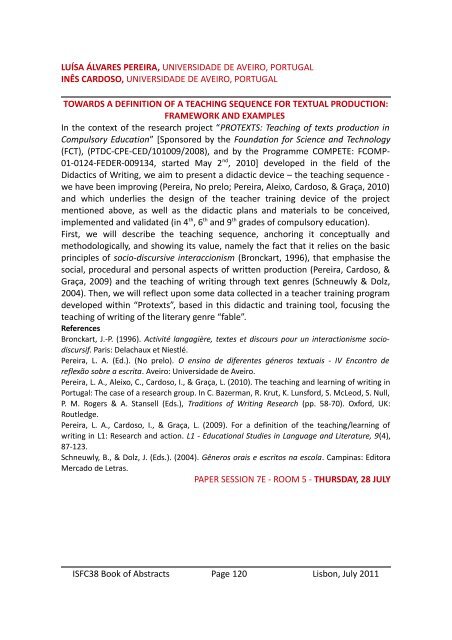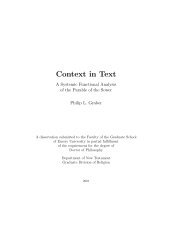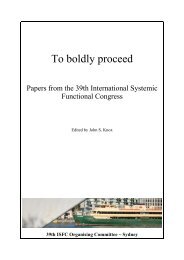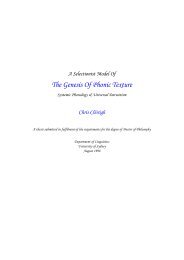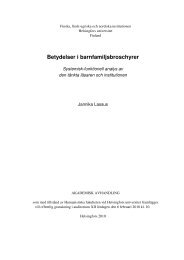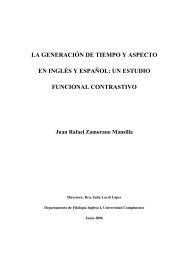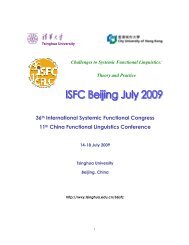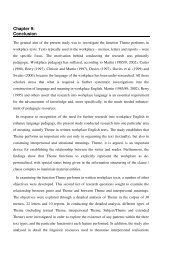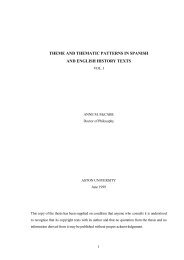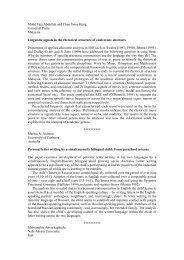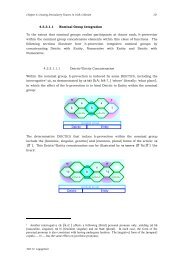Abstracts - Faculdade de Letras da Universidade de Lisboa
Abstracts - Faculdade de Letras da Universidade de Lisboa
Abstracts - Faculdade de Letras da Universidade de Lisboa
- No tags were found...
You also want an ePaper? Increase the reach of your titles
YUMPU automatically turns print PDFs into web optimized ePapers that Google loves.
LUÍSA ÁLVARES PEREIRA, UNIVERSIDADE DE AVEIRO, PORTUGALINÊS CARDOSO, UNIVERSIDADE DE AVEIRO, PORTUGALTOWARDS A DEFINITION OF A TEACHING SEQUENCE FOR TEXTUAL PRODUCTION:FRAMEWORK AND EXAMPLESIn the context of the research project “PROTEXTS: Teaching of texts production inCompulsory Education” [Sponsored by the Foun<strong>da</strong>tion for Science and Technology(FCT), (PTDC-CPE-CED/101009/2008), and by the Programme COMPETE: FCOMP-01-0124-FEDER-009134, started May 2 nd , 2010] <strong>de</strong>veloped in the field of theDi<strong>da</strong>ctics of Writing, we aim to present a di<strong>da</strong>ctic <strong>de</strong>vice – the teaching sequence -we have been improving (Pereira, No prelo; Pereira, Aleixo, Cardoso, & Graça, 2010)and which un<strong>de</strong>rlies the <strong>de</strong>sign of the teacher training <strong>de</strong>vice of the projectmentioned above, as well as the di<strong>da</strong>ctic plans and materials to be conceived,implemented and vali<strong>da</strong>ted (in 4 th , 6 th and 9 th gra<strong>de</strong>s of compulsory education).First, we will <strong>de</strong>scribe the teaching sequence, anchoring it conceptually andmethodologically, and showing its value, namely the fact that it relies on the basicprinciples of socio-discursive interaccionism (Bronckart, 1996), that emphasise thesocial, procedural and personal aspects of written production (Pereira, Cardoso, &Graça, 2009) and the teaching of writing through text genres (Schneuwly & Dolz,2004). Then, we will reflect upon some <strong>da</strong>ta collected in a teacher training program<strong>de</strong>veloped within “Protexts”, based in this di<strong>da</strong>ctic and training tool, focusing theteaching of writing of the literary genre “fable”.ReferencesBronckart, J.-P. (1996). Activité langagière, textes et discours pour un interactionisme sociodiscursif.Paris: Delachaux et Niestlé.Pereira, L. A. (Ed.). (No prelo). O ensino <strong>de</strong> diferentes géneros textuais - IV Encontro <strong>de</strong>reflexão sobre a escrita. Aveiro: Universi<strong>da</strong><strong>de</strong> <strong>de</strong> Aveiro.Pereira, L. A., Aleixo, C., Cardoso, I., & Graça, L. (2010). The teaching and learning of writing inPortugal: The case of a research group. In C. Bazerman, R. Krut, K. Lunsford, S. McLeod, S. Null,P. M. Rogers & A. Stansell (Eds.), Traditions of Writing Research (pp. 58-70). Oxford, UK:Routledge.Pereira, L. A., Cardoso, I., & Graça, L. (2009). For a <strong>de</strong>finition of the teaching/learning ofwriting in L1: Research and action. L1 - Educational Studies in Language and Literature, 9(4),87-123.Schneuwly, B., & Dolz, J. (Eds.). (2004). Gêneros orais e escritos na escola. Campinas: EditoraMercado <strong>de</strong> <strong>Letras</strong>.PAPER SESSION 7E - ROOM 5 - THURSDAY, 28 JULYISFC38 Book of <strong>Abstracts</strong> Page 120 Lisbon, July 2011


